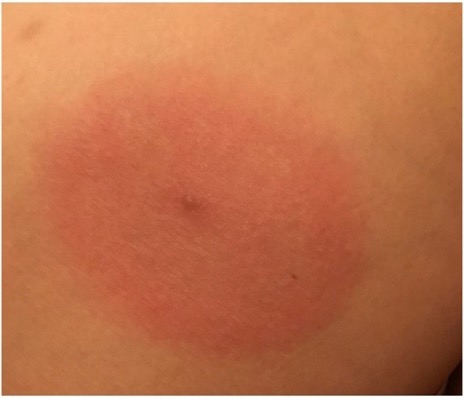
Spring is just around the corner and outdoor excursions are finally on the horizon. This means fresh air, afternoon playdates, and picnics. It also means sunscreen, bug spray and “tick checks.” Keeping an eye out for pesky bugs, especially ticks, is an important step in safeguarding our families’ health.
Ticks can carry a host of bloodborne illnesses. The most prevalent in our area is Lyme Disease. But what is Lyme Disease? How do you know if your family has been exposed? And, most importantly, what should you do if you’ve got it? Let’s take a closer look.
What is Lyme disease?
Lyme disease is an infection caused by the bacteria, Borrelia burgdorferi. We become infected after being bitten by an infected tick. In Rockland County, deer ticks are most likely to spread the disease.
A few things to know:
- A tick must bite and then attach to the skin for at least 24 hours before it can spread the bacteria and cause an infection.
- If left untreated, the bacteria can cause widespread infection.
- While tick bites can happen throughout the year, they are most common during warm weather months from March through September.
How will I know if I have Lyme Disease?
If you’ve been bitten by a tick or suspect that you might have had a tick bite, look for these symptoms described by the Centers for Disease Control and Prevention (CDC):
Early Localized Infection:
Look for these symptoms 3 to 30 days after a tick bite.
- Chills, fever, headaches, fatigue, muscle and joint pain, and a circular rash that often looks like a bullseye (known medically as a erythema migrans).
- This type of rash, pictured below, is a very common symptom and occurs in 80% of people with diagnosed Lyme Disease. It can develop anywhere on the body, including the scalp, and might go unnoticed.

Early Disseminated Disease:
Look for these symptoms days to weeks after a tick bite.
- Nerve pain or numbness, weakness or paralysis of facial muscles, palpitations or chest pains, shortness of breath, lightheadedness or fainting.
Late Disseminated Disease:
Look for these symptoms months to years after a tick bite.
- Facial palsy (loss of muscle tone or droop on one or both sides of the face), arthritis with severe joint pain and swelling, particularly the knees and other large joints, intermittent pain in tendons, muscles, joints, and bones, heart palpitations or an irregular heartbeat (Lyme carditis).
Lyme Disease presents in a number of symptoms. Some are severe and worrisome. When detected early, treatment with antibiotics results in a quick and full recovery!
How is Lyme Disease diagnosed?
If you experience symptoms after a tick bite, check-in with your primary care provider. Your provider will:
- Conduct a careful physical examination and ask questions about possible tick exposure; and
- Perform a blood test to confirm diagnosis.
Please remember, many people with Lyme Disease never see a tick on their body! If you’ve spent time outside, pay close attention to your health and reach out to your provider if you have any of the above symptoms especially an expanding, circular rash.
How is Lyme Disease treated?
In most cases, Lyme disease can be cured with a few weeks of antibiotics. A 10 to 21-day course of doxycycline, amoxicillin or cefuroxime, is usually recommended based on age and if you are pregnant or breastfeeding. For a full recovery, take antibiotics promptly and as directed. Symptoms might linger after you’ve completed a round of antibiotics, but usually subside overtime. Reach out to your provider if you’re concerned.
What steps can you take to prevent Lyme Disease?
Try these tricks to limit your family’s exposure:
- Use insect repellent containing diethyltoluamide (DEET) or spray clothing with a tick-killing spray containing permethrin;
- Wear protective clothing and shoes that cover the entire foot and lower legs;
- Avoid grassy, brushy, and wooded areas, especially in May, June, and July;
- Upon returning from tick-infested areas, conduct a full-body tick check and examine gear and pets for ticks; and
- Promptly, remove any ticks. Tuck the tick into a plastic bag. If you develop symptoms, your provider might recommend sending the insect away for testing.
Quick Recap
As our weather turns warmer, tick born infections increase. Most common is Lyme Disease. Early-stage Lyme presents in flu like symptoms, including headache, fever, muscle and joint pain and chills. Most characteristic is the bullseye rash that appears 3 to 30 days after exposure. To protect yourself and family, keep DEET tick repellent spray handy, wear clothing that covers your body and avoid grassy and heavily wooded areas. Don’t forget to commence a full body tick check after you’ve been out!
And, if you do develop symptoms after a tick bite or possible exposure in tick infested areas, check-in with your primary care provider. When caught in the early stages, Lyme Disease is easily treated with a round of antibiotics.
References:
Clinical Infectious Diseases, Volume 72, Issue 1, 1 January 2021, Pages e1-e48, https://doi.org/10.1093/cid/ciaa1215
Published (online): 30 November 2020